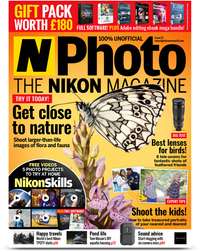I always shoot Raw images and here’s why you should too
A recent incident made me thankful I always shoot Raw, and it had nothing to do with image quality

Last month I attended a sci-fi-themed portrait event, courtesy of The Creativity Hub. The futuristic aesthetic was a perfect excuse to showcase the incredible versatility of Rotolight’s latest colour-changing LED lights the AEOS 2 and NEO 3. However, I was also having fun manually controlling my white balance to alter the colour quality in-camera, going all the way up to 10,000K.
It was a great shoot, but with a three-hour journey home as soon as the event finished I hastily packed up my kit and hit the road. Cue a week of feverishly typing up articles for N-Photo 138’s impending deadline – and barely looking at my camera – before I was off again to meet nature-pro Ross Hoddinott and lucky N-Photo reader Matthew Barber to document a one-on-one workshop for an article the magazine calls Apprentice. You’ve probably worked out where this is going…
• Read more: The best LED light panels
Occasionally during an Apprentice shoot, I’ll find enough downtime to pause my note taking and capture a few images of my own. I’d always wanted to photograph common blue butterflies, so I found my window of opportunity and set to work. Since I was focusing manually, most of my attention when checking Playback was to ensure each image was sharp. And since I was shooting in the middle of a meadow (and rushing to get back to the job at hand), I paid little attention to each image’s decidedly yellow hue.
Following a very successful shoot, we all piled into a nearby pub to grab a bite and sift through the best photographs from the day. It was here that Matthew explained he had never shot Raw before.
Ross eloquently explained the file format’s many benefits, chief of which is the additional flexibility in post-production. Matthew admitted that he preferred to let the camera do the talking and was therefore reluctant to edit – a sentiment that’s been shared by many other apprentices and N-Photo readers.
However, as Ross quite rightly pointed out, JPEGs actually have some degree of processing baked into them, which is why they appear brighter and bolder than Raw files. Just like a juicy slab of raw meat, Raw files are a blank canvas that need to be edited (or cooked) to achieve the best results.
Get the Digital Camera World Newsletter
The best camera deals, reviews, product advice, and unmissable photography news, direct to your inbox!
I then interjected with my own words of wisdom, explaining to Matthew that you can change a Raw file’s white balance in post, but if you get it wrong shooting JPEG, there’s little you can do. And then it dawned on me… my white balance was still set to 10,000K…!
It's a good job I always shoot Raw.
N-Photo: The Nikon Magazine is a monthly publication that's entirely dedicated to Nikon users. For the best news, reviews, projects and more, subscribe to N-Photo today!
Read more:
Best DSLRs
The best camera under $500/£500
The best cameras for enthusiasts
The best Nikon lenses
The best Nikon camera

Mike is Digital Camera World's How To Editor. He has over a decade of experience, writing for some of the biggest specialist publications including Digital Camera, Digital Photographer and PhotoPlus: The Canon Magazine. Prior to DCW, Mike was Deputy Editor of N-Photo: The Nikon Magazine and Production Editor at Wex Photo Video, where he sharpened his skills in both the stills and videography spheres. While he's an avid motorsport photographer, his skills extend to every genre of photography – making him one of Digital Camera World's top tutors for techniques on cameras, lenses, tripods, filters and other imaging equipment – as well as sharing his expertise on shooting everything from portraits and landscapes to abstracts and architecture to wildlife and, yes, fast things going around race tracks...

